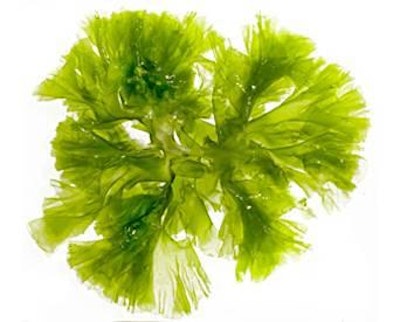
When we think of algae, our mind goes to seaweeds -- a nuisance or curiosity for sea swimmers, or to edible algae used in Far East cuisine delicacies. Few realize that marine algae are used to extract hydrocolloids, such as carrageenan and agar, used extensively as gelling and emulsifying agents in many human foods, worldwide. Yet, even fewer know that marine algae, and namely macro-algae, are currently being investigated for their multifaceted health properties in human and animals. Indeed, seen from a functional feed perspective, the right type or combination of marine algae can offer the following five advantages:
1. Immune modulation
The cell wall of algae is an extremely complex structure composed of distinct polysaccharides. Some of these compounds appear to enhance the immune activity of animals. For example, carrageenans and agar, both polysaccharides from red algae, have been shown to improve the immunomodulating activities in mammals by modifying the activity of macrophages stimulating phagocytosis. In addition, some carrageenans induce a strong activation of macrophages.Ulvans from green algae also exert immunomodulating properties by activating the expression of some cytokines and chemokines involved in innate and adaptive immune response. Such effects are of particular interest in diseases where the immune system is impaired or can benefit from a boost. This is the case, for example, in young animals or during the vaccination period. It is interesting to note that such immunostimulating activities require the presence of sulphated polysaccharides, which abound in algae but are absent from most terrestrial plans.
2. Stimulation of mucin secretion
Intestinal mucins are glycoproteins that coat the luminal surface of the enteric epithelium forming a protective gel that acts as a barrier against mechanical insults, bacterial colonization, bacterial toxins and, of course, from self-digestion. Thus, anything that enhances mucin production (from intestinal goblet cells) will enhance the mucin barrier leading to enhancedanimal gut health. Data from a laboratory trial illustrated that algal polysaccharides (alginate and ulvan) can increase mucin secretion, indeed. The same was true for the fermentation products (acetate and butyrate) of these algal polysaccharides. Although this remains a laboratory study, and as such its results -- albeit interesting -- should be interpreted with care, it is highly likely farm animals will respond in a similar manner, something that pends verification.
3. Management of fat metabolism (digestive health)
Fatty liver syndrome in sows and hens is a perennial problem with no current solution. To this end, certain extracts from algae might prove to be beneficial as they have shown to possess strong activity against hyperlipidemia. In fact, such algae extracts are used to manage high cholesterol in humans. Algae extracts are considered especially powerful in controlling hyperlipidemia because such effects depend on the ion-exchange capacity, something that is found to be particularly strong in algae. It is interesting to note that certain algal polysaccharides, such as agar from brown algae, can combine with calcium salt (unless already saturated with calcium). This might require further elucidation in the case of aging hens that suffer from low calcium absorption.
4. Prebiotic activity
Algae are rich in polysaccharides that bypass digestion at the upper parts of the gut and can serve as substrate for microbial growth at the lower part of the gut (two conditions necessary for all prebiotics). Such polysaccharides include alginates (up to 45 percent in certain algae), laminarin and fucans, whereas commercial products usually contain a varying mixture (extract) of many diverse polysaccharides. Studies conducted with young pigs indicated that products based on laminarin provide a prebiotic effect similar to that of lactose: marine algal extracts improved growth, most likely due to enhanced counts of beneficial bacteria (lactobacilli, bifidobacteria) against those of pathogenic orientation (colibacteria). The possible lactose-replacement effect is of particular interest as it can offer substantial feed cost savings. In addition, a recent study indicated that adding a brown algal product in broiler feeds provided the same growth-promoting effects as inulin (another prebiotic) and (or) virginiamycin (a common antibiotic). As such, algal products may offer a new alternative to antibiotic-free nutrition programs for non-ruminant animals.
5. Interaction of algal polysaccharides and clay for mycotoxin management
Research based on a modified clay product indicated that treatment with algal polysaccharides increases the absorptive capacity of clay. This in turn results in a significant increase in mycotoxin binding capacity of the modified clay. Interestingly, such treatment allows for lower clay inclusion rates (from the usual 10 down to 1 kg per metric tone), under normal mycotoxin contamination levels, something that reduces or eliminates the problem of vitamin binding by the clay. A low-inclusion anti-mycotoxin product offers substantial savings in the formulation and logistics of feed supplement packages.

















